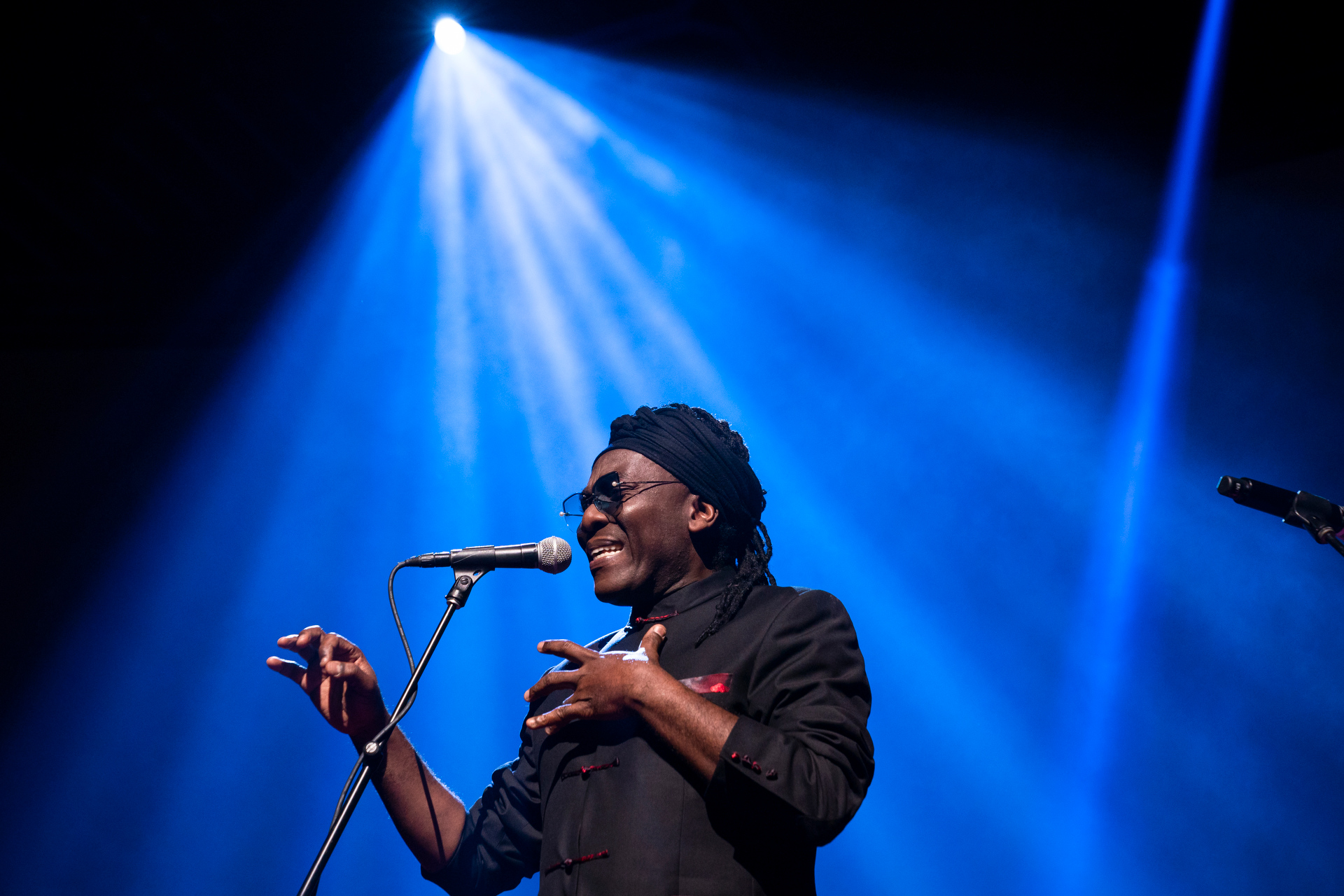
Multi-instrumental genius, Grammy winner and songwriter Richard Bona held the audience spellbound at TED2019: Bigger Than Us, April 18, 2019, Vancouver, BC, Canada. Photo: Bret Hartman / TED
Session 11 of TED2019 amazed, enriched, inspired and dazzled — diving deep into the creative process, exploring what it’s like to be a living artwork and soaring into deep space.
The event: Talks and performances from TED2019, Session 11: Wonder, hosted by TED’s Helen Walters and Kelly Stoetzel
When and where: Thursday, April 18, 2019, 5pm, at the Vancouver Convention Centre in Vancouver, BC
Speakers: Beau Lotto with performers from Cirque du Soleil, Joseph Gordon-Levitt, Jon Gray, Daniel Lismore, Richard Bona, Es Devlin and Juna Kollmeier
Music: Multi-instrumentalist and singer-songwriter Richard Bona, mesmerizing the audience with his “magic voodoo machine” — weaving beautiful vocal loops into a mesh of sound
Beau Lotto, neuroscientist, accompanied by performers and artists from Cirque du Soleil
- Big idea: Awe is more than an experience; it’s a physiological state of mind, one that could positively influence how we approach conflict and uncertainty.
- How? Humans possess a fundamental need for closure that, when unmet, often turns to conflict-heavy emotions like fear and anger. The antidote may be one of our most profound perceptual experiences: awe. Lotto and his team recorded the brain activity of 280 people before, during and after watching a Cirque du Soleil performance, discovering promising insights. In a state of awe, research shows that humans experience more connection to others and more comfort with uncertainty and risk-taking. These behaviors demonstrate that a significant shift in how we approach conflict is possible — with humility and courage, seeking to understand rather than convince. Read how this talk was co-created by Beau Lotto’s Lab of Misfits and the Cirque du Soleil.
- Quote of the talk: “Awe is neither positive nor negative. What’s really important is the context in which you create awe.”
Joseph Gordon-Levitt, actor, filmmaker and founder of HITRECORD
- Big idea: If your creativity is driven by a desire to get attention, you’re never going to be creatively fulfilled. What drives truly fulfilling creativity? Paying attention.
- How? Social media platforms are fueled by getting attention, and more and more people are becoming experts at it — turning creativity from a joyous expression into a means to an end. But while Joseph Gordon-Levitt certainly knows what it feels like to get attention — he’s been in show business since he was 6, after all — he realized that the opposite feeling, paying attention, is the real essence of creativity. He describes the feeling of being locked in with another actor — thinking about and reacting only to what they’re doing, eliminating thoughts about himself. So get out there and collaborate, he says. Read more about Joseph Gordon-Levitt’s talk here.
- Quote of the talk: “It’s like a pavlovian magic spell: rolling, speed, marker (clap), set and action. Something happens to me, I can’t even help it. My attention narrows. And everything else in the world, anything else that might be bothering, or that might otherwise grab my attention, it all goes away.”
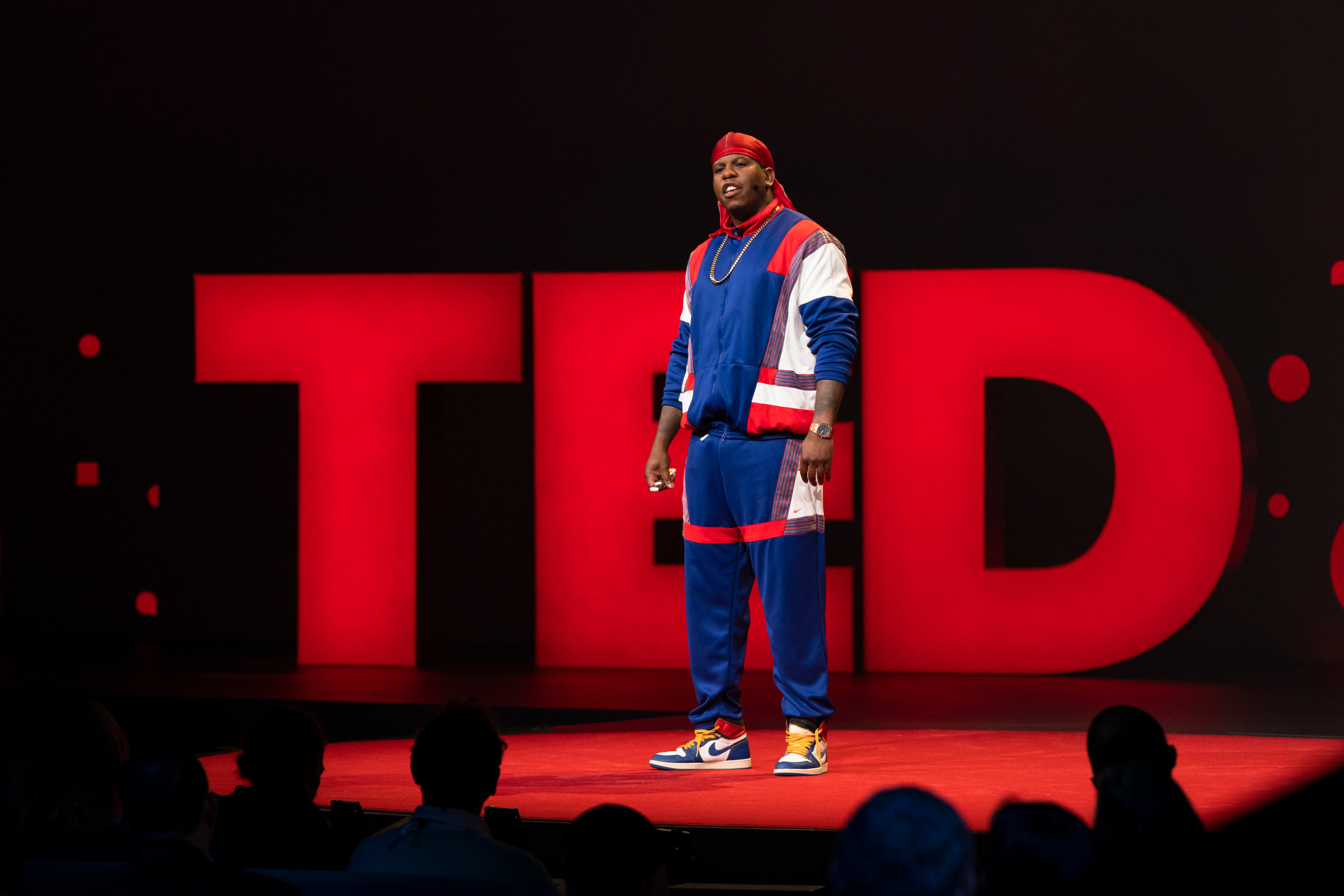
“We decided the world needed some Bronx seasoning on it”: The founder of Ghetto Gastro, Jon Gray, speaks at TED2019: Bigger Than Us. April 18, 2019, Vancouver, BC, Canada. Photo: Ryan Lash / TED
Jon Gray, designer, food lover, entrepreneur and cofounder of Ghetto Gastro
- Big idea: We can bring people together, connect cultures and break stereotypes through food.
- How? Jon Gray is a founder of Ghetto Gastro, a collective based in the Bronx that works at the intersection of food, art and design. Their goal is to craft products and experiences that challenge perceptions. At first, Gray and his co-creators aimed to bring the Bronx to the wider world. Hosting an event in Tokyo, for example, they served a Caribbean patty made with Japanese Wagyu beef and shio kombu — taking a Bronx staple and adding international flair. Now Ghetto Gastro is bringing the world to the Bronx. The first step: their recently opened “idea kitchen” — a space where they can foster a concentration of cultural and financial capital in their neighborhood.
- Quote of the talk: “Breaking bread has always allowed me to break the mold and connect with people.”
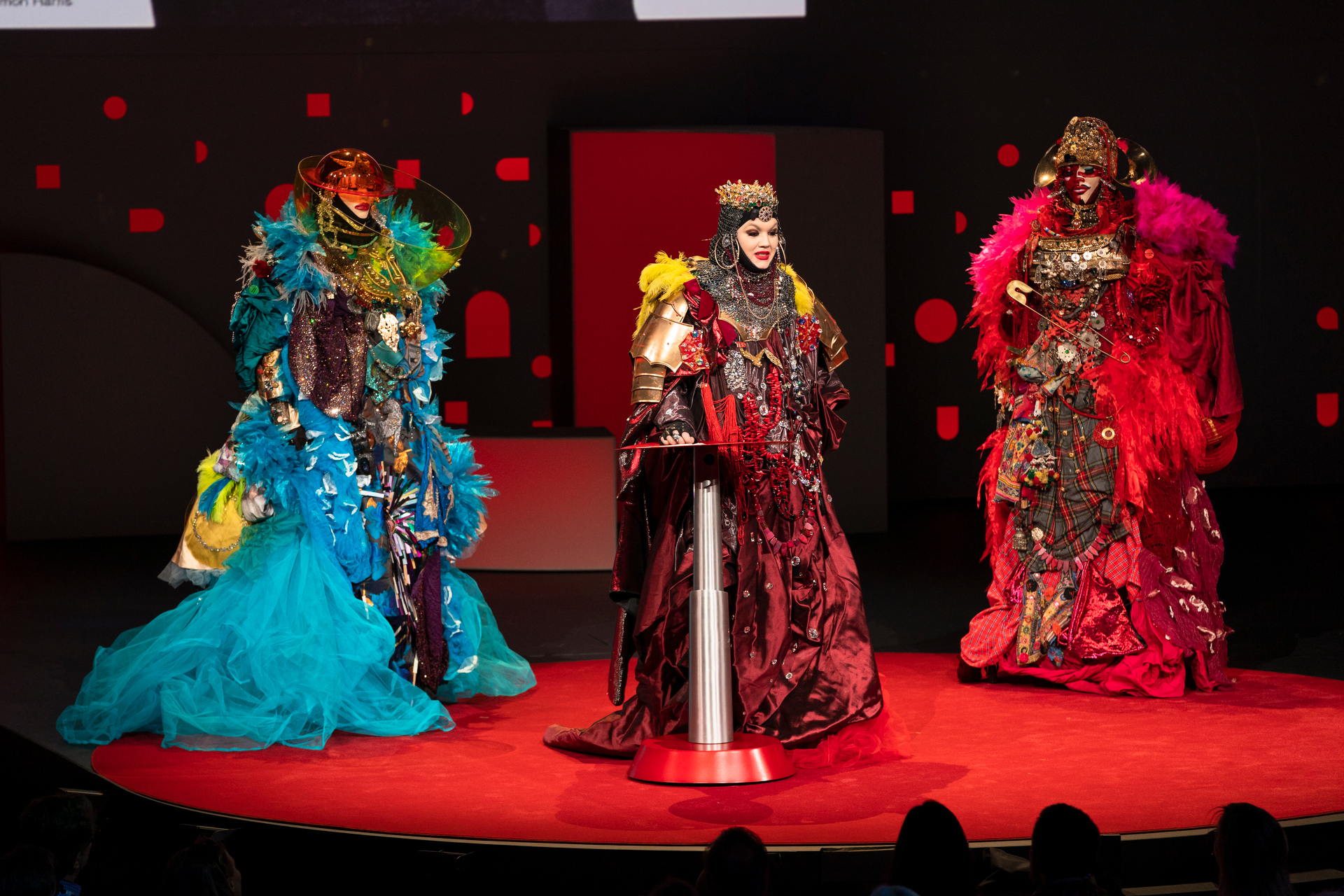
“These artworks are me”: Daniel Lismore talks about his life as a work of art, created anew each morning. He speaks at TED2019: Bigger Than Us. April 15 – 19, 2019, Vancouver, BC, Canada. Photo: Ryan Lash / TED
Daniel Lismore, London-based artist who lives his life as art, styling elaborate ensembles that mix haute couture, vintage fabrics, found objects, ethnic jewelry, beadwork, embroidery and more
- Big idea: We can all make ourselves into walking masterpieces. While it takes courage — and a lot of accessories — to do so, the reward is being able to express our true selves.
- How? Drawing from a massive, 6,000-piece collection that occupies a 40-foot container, three storage units and 30 IKEA boxes, Lismore creates himself anew every day. His materials range from beer cans and plastic crystals to diamonds, royal silks and 2,000-year-old Roman rings. And he builds his outfits from instinct, piling pieces on until — like a fashion-forward Goldilocks — everything feels just right.
- Quote of the talk: “I have come to realize that confidence is a concept you can choose. I have come to realize that authenticity is necessary and it’s powerful. I have spent time trying to be like other people; it didn’t work. it’s a lot of hard work not being yourself.”
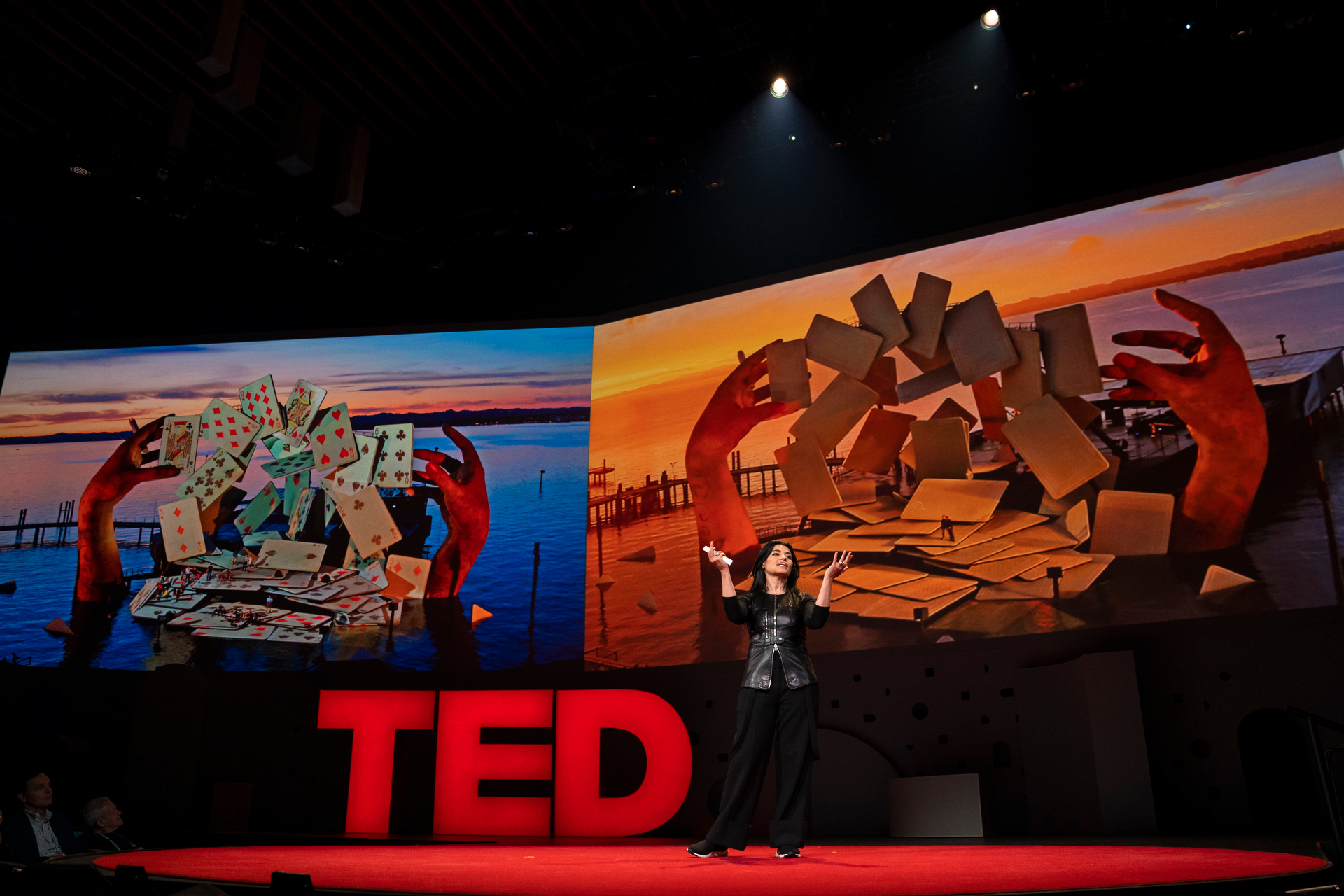
“So much of what I make is fake. It’s an illusion. And yet every artist works in pursuit of communicating something that’s true.” Artist and stage designer Es Devlin speaks at TED2019: Bigger Than Us, April 18, 2019, Vancouver, BC, Canada. Photo: Bret Hartman / TED
Es Devlin, artist and stage designer
- Big idea: Art is about communication and expression, and designers have the power to foster lasting connections and deep empathy with their work.
- How? Es Devlin weaves boundless thinking into her stunning stage designs, emphasizing empathy, intimacy and connection for the performers and the audience. As a set designer for some of the world’s most iconic performers and events — including Beyoncé’s Formation tour, Adele’s first live concert in five years, U2 and Kanye West, among many others — Devlin dives into the heart of each performer’s work. She sculpts visual masterpieces that reflect the shape and sound of each artist she works with. Audiences come to shows for connection and intimacy, Devlin says, and it’s the task of set designers, directors and artists to deliver it for the fans.
- Quote of the talk: “Most of what I’ve made over the last 25 years doesn’t exist anymore — but our work endures in memories, in synaptic sculptures in the minds of those who were once present in the audience.”
Juna Kollmeier, astrophysicist
- Big idea: Mapping the observable universe is … a pretty epic proposition. But it’s actually humanly achievable.
- How? We’ve been mapping the stars for thousands of years, but the Sloan Digital Sky Survey is on a special mission: to create the most detailed three-dimensional maps of the universe ever made. Led by Kollmeier, the project divides the sky into three “mappers” that it documents: galaxies, black holes and stars. Our own Milky Way galaxy has 250 billion(ish) stars. “That is a number that doesn’t make practical sense to pretty much anybody,” says Kollmeier. We’re not going to map all of those anytime soon. But galaxies? We’re getting there. On our current trajectory, we’ll map every large galaxy in the observable universe by 2060, she says.
- Quote of the talk: “Black holes are among the most perplexing objects in the universe. Why? Because they are literally just math incarnate in a physical form that we barely understand.”
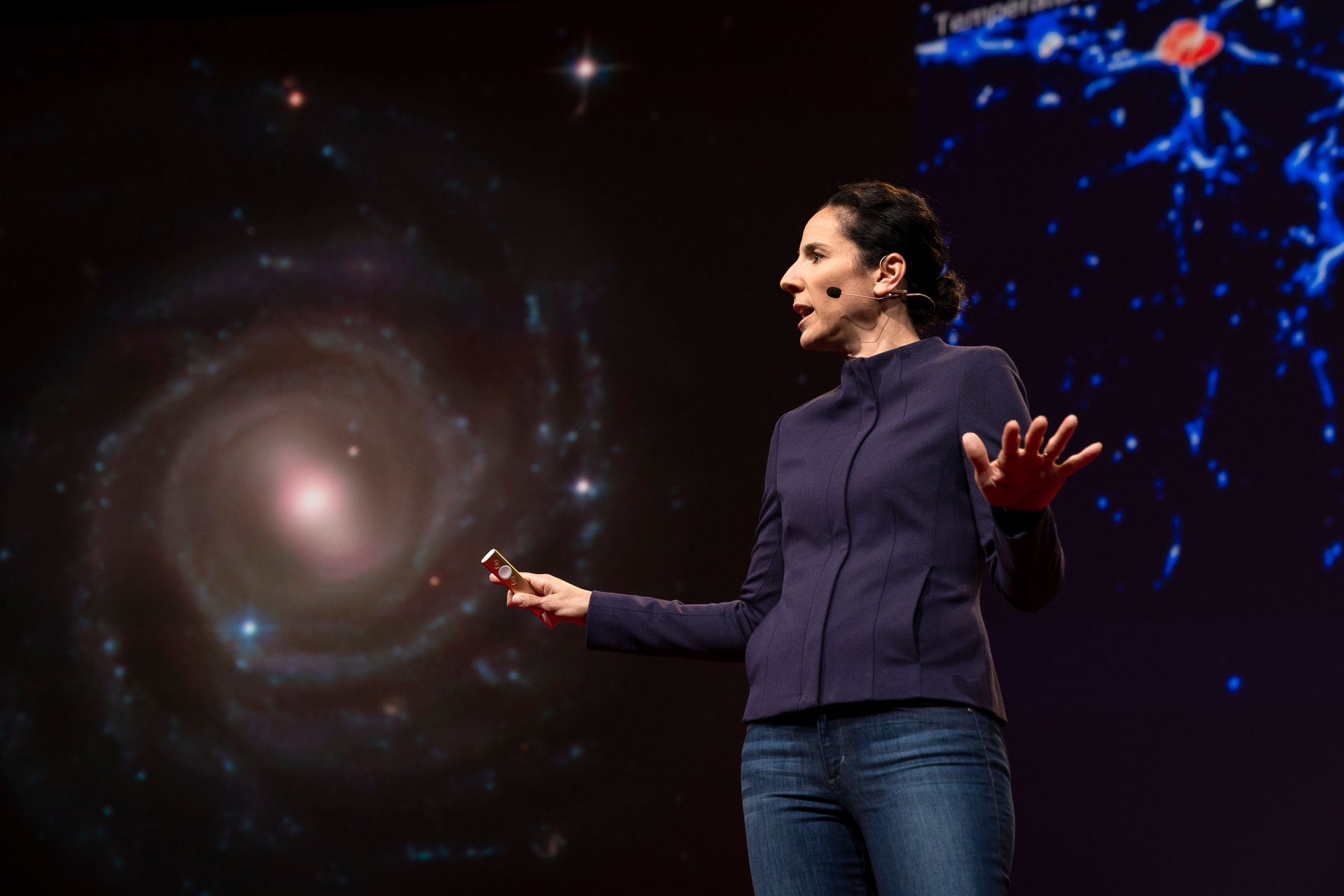
“Stars are exploding all the time. Black holes are growing all the time. There is a new sky every night”: Astronomer Juna Kollmeier speaks at TED2019: Bigger Than Us, April 18, 2019, Vancouver, BC, Canada. Photo: Bret Hartman / TED